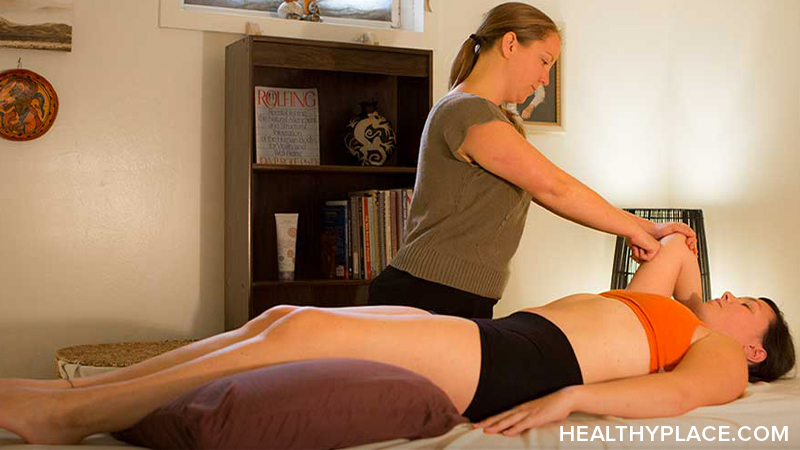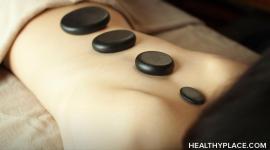Rolfing Structural Integration

Learn about Rolfing, deep tissue massage for relieving stress and improving mobility. May be helpful for chronic fatigue syndrome too.
Before engaging in any complementary medical technique, you should be aware that many of these techniques have not been evaluated in scientific studies. Often, only limited information is available about their safety and effectiveness. Each state and each discipline has its own rules about whether practitioners are required to be professionally licensed. If you plan to visit a practitioner, it is recommended that you choose one who is licensed by a recognized national organization and who abides by the organization's standards. It is always best to speak with your primary health care provider before starting any new therapeutic technique.
Background
After receiving her Ph.D. in biological chemistry from Columbia University, New York, in 1920, Dr. Ida P. Rolf developed Rolfing® structural integration. She established the Guild for Structural Integration in the 1960s and the Rolf Institute of Structural Integration in Boulder, Colo., in 1971.
Rolfing® structural integration involves deep tissue massage aimed at relieving stress and improving mobility, posture, balance, muscle function and efficiency, energy and overall well being. Practitioners apply slow-moving pressure with their knuckles, thumbs, fingers, elbows and knees to the muscles, tissue around the muscles and other soft tissue. Rolfing® structural integration concentrates on opposing muscle groups, such as the biceps and triceps in the upper arms.
Certified Rolfing® practitioners are certified by the Rolf Institute to deliver structural integration services. Training may take one to two years to complete (731 to 806 hours). Principles and techniques are based on the work of Dr. Rolf. Rolfing® structural integration has also been referred to as somatic ontology.
Theory
Rolfing® structural integration is based on the belief that the tissues surrounding muscles become stiff and thickened with age, leading to musculoskeletal dysfunction and misalignment of the body. By working the muscles and muscle tissue, practitioners aim to improve these problems. Practitioners assert that people who undergo this therapy will become more comfortable with their movements and more aware of their body in space, and they will experience improved alignment.
Evidence
Scientists have studied Rolfing® structural integration for the following uses:
Low back pain
There is a report of a young adult with chronic low back pain and pelvic asymmetry who improved with Rolfing® structural integration. This is not enough information to form a firm conclusion about the effectiveness of Rolfing® structural integration for back pain.
Cerebral palsy
A small study in cerebral palsy patients receiving Rolfing® structural integration reports slight benefits in movement. This is not enough information to form a clear conclusion about effectiveness.
Chronic fatigue syndrome
A small study evaluated the effects of Rolfing® structural integration on cardiovascular endurance in people with chronic fatigue syndrome. Patients showed improvement in symptoms. A large, well-designed study is necessary to confirm these preliminary results and make a conclusion.
Unproven Uses
Rolfing® structural integration has been suggested for many uses, based on tradition or on scientific theories. However, these uses have not been thoroughly studied in humans, and there is limited scientific evidence about safety or effectiveness. Some of these suggested uses are for conditions that are potentially life-threatening. Consult with a health care provider before using Rolfing® structural integration for any use.
| Amyotrophic lateral sclerosis Anxiety Balance B-cell cancers Carpal tunnel syndrome Energy boosting Enhanced absorption of insulin injections Headache Hyperthyroidism Improved appearance Improved athletic performance Improved mobility | Internal strains Lumbar lordosis Meningioma Muscular pain in craniocervicomandibular syndrome Neck pain Osteoarthritis Parkinson's disease Poor posture Soft tissue disorders Spinal problems Stress Whiplash |
Potential Dangers
Rolfing® structural integration is generally believed to be safe in most people. Because Rolfing® structural integration involves deep manipulation of tissues, some people should avoid this technique, including people with broken bones, severe osteoporosis, disease of the spine or vertebral disks, skin damage or wounds, bleeding disorders, or blood clots in areas being manipulated. People taking blood thinners such as warfarin (Coumadin) should also avoid Rolfing® structural integration. People with joint diseases such as rheumatoid arthritis, ankylosing spondylitis or aortic aneurisms should speak with their health care provider if considering Rolfing® structural integration.
People who have had procedures or diseases affecting the abdomen should speak with their health care provider before starting Rolfing® structural integration. There is a report that deep tissue massage moved a ureteral stent out of its proper position.
Pregnant women should avoid Rolfing® structural integration.
Some certified Rolfing® practitioners discourage structural integration services in people with psychosis or bipolar disorder and suggest that therapy may cause the release of suppressed memories of severe emotional anguish, although there is no known scientific basis for these precautions. It has also been suggested that Rolfing® structural integration be used cautiously in women who are menstruating and in people with severe diseases of the kidneys, liver or intestines, although there is no scientific information in these areas.
Rolfing® structural integration should not be used as the sole therapeutic approach to disease, and it should not delay the time it takes to speak with a health care provider about a potentially severe condition.
Summary
Rolfing® structural integration has been suggested for many conditions. There is little well-designed scientific research of this technique, and it is not known if Rolfing® structural integration is safe or effective for the treatment of any disease. People with fractures or spine disease, those at risk of bleeding, those with blood clots and pregnant women should avoid Rolfing® structural integration.
The information in this monograph was prepared by the professional staff at Natural Standard, based on thorough systematic review of scientific evidence. The material was reviewed by the Faculty of the Harvard Medical School with final editing approved by Natural Standard.
Resources
- Natural Standard: An organization that produces scientifically based reviews of complementary and alternative medicine (CAM) topics
- National Center for Complementary and Alternative Medicine (NCCAM): A division of the U.S. Department of Health & Human Services dedicated to research
Selected Scientific Studies: Rolfing® Structural Integration
Natural Standard reviewed more than 45 articles to prepare the professional monograph from which this version was created.
Some of the available studies are listed below:
- Bernau-Eigen M. Rolfing: a somatic approach to the integration of human structures. Nurse Pract Forum 1998;9(4):235-242.
- Cameron DF, Hushen JJ, Colina L, et al. Formation and structure of transplantable tissue constructs generated in simulated microgravity from sertoli cells and neuron precursors. Cell Transplant 2004;13(7-8):755-763.
- Cottingham JT, Maitland J. A three-paradigm treatment model using soft tissue mobilization and guided movement-awareness techniques for a patient with chronic low back pain: a case study. J Orthoped Sports Phys Ther 1997;26(3):155-167.
- Cottingham JT, Porges SW, Lyon T. Effects of soft tissue mobilization (Rolfing pelvic lift) on parasympathetic tone in two age groups. Phys Ther 1988;68(3):352-356.
- Cottingham JT, Porges SW, Richmond K. Shifts in pelvic inclination angle and parasympathetic tone produced by Rolfing soft tissue manipulation. Phys Ther 1988;68(9):1364-1370.
- Deutsch JE, Derr LL, Judd P, et al. Treatment of chronic pain through the use of structural integration (rolfing). Orthopaedic Phys Ther Clin North America 2000;9(3):411-425.
- Froment Y. Therapeutic renewal. Rolfing or structural integration. Krankenpfl Soins Infirm 1984; 77(6); 68-69.
- Goffard JC, Jin L, Mircescu H, et al. Gene expression profile in thyroid of transgenic mice overexpressing the adenosine receptor 2a. Mol Endocrinol 2004;18(1):194-213.
- James HG, Robertson KB, Powers N. Biomechanical structuring for figure skaters. Preliminary pilot study report presented to the USFSA Research Committee, 1988; pp. 1-22.
- Jones TA. Rolfing. Phys Med Rehabil Clin N Am 2004;15(4):799-809.
- Kerr HD. Ureteral stent displacement associated with deep massage. WMJ 1997;96(12):57-58.
- Perry J, Jones MH, Thomas L. Functional evaluation of Rolfing in cerebral palsy. Dev Med Child Neurol 1981;23(6):717-729.
- Rolf IP. Structural Integration. J Institute Compar Study History Philos Sciences 1963;1(1):3-19.
- Rolf IP. Structural integration: a contribution to the understanding of stress. Confin Psychiatr 1973;16(2):69-79.
- Rosa G, Piris MA. IgV(H) and bc16 somatic mutation analysis reveals the heterogenicity of cutaneous B-cell lymphoma, and indicates the presence of undisclosed local antigens. Mod Pathol 2004;17(6):623-630.
- Santoro F, Maiorana C, Geirola R. Neuromascular relaxation and CCMDP. Rolfing and applied kinesiology. Dent Cadmos 1989; 57(17):76-80.
- Silverman J, Rappaport M, Hopkins HK, et al. Stress, stimulus intensity control, and the structural integration technique. Confin Psychiatr 1973;16(3):201-219.
- Sulman EP, White PS, Brodeur GM. Genomic annotation of the meningioma tumor suppressor locus on chromosome 1p34. Oncogene 2004;23(4):1014-1020.
- Talty CM, DeMasi I, Deutsch JE. Structural integration applied to patients with chronic fatigue syndrome: a retrospective chart review. J Orthopaedic Sports Phys Ther 1998;27(1):83.
- Weinberg RS, Hunt VV. Effects of structural integration on state-trait anxiety. J Clin Psychol 1979;35(2):319-322.
back to: Alternative Medicine Home ~ Alternative Medicine Treatments
APA Reference
Staff, H.
(2008, December 2). Rolfing Structural Integration, HealthyPlace. Retrieved
on 2026, January 14 from https://www.healthyplace.com/alternative-mental-health/treatments/rolfing-structural-integration


